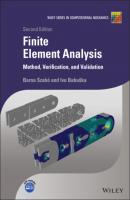Finite Element Analysis. Barna Szabó
Чтение книги онлайн.

Читать онлайн книгу Finite Element Analysis - Barna Szabó страница 21
Название: Finite Element Analysis
Автор: Barna Szabó
Издательство: John Wiley & Sons Limited
Жанр: Физика
isbn: 9781119426462
isbn:
Proof: Let
The first term on the right is
Theorem 1.4 states that the error depends on the exact solution of the problem
The finite element method is a flexible and powerful method for constructing trial spaces. The basic algorithmic structure of the finite element method is outlined in the following sections.
1.3.1 The standard polynomial space
The standard polynomial space of degree p, denoted by
(1.49)
The choice of basis functions is guided by considerations of implementation, keeping the condition number of the coefficient matrices small, and personal preferences. For the symmetric positive‐definite matrices considered here the condition number C is the largest eigenvalue divided by the smallest. The number of digits lost in solving a linear problem is roughly equal to
The standard polynomial basis functions, called shape functions, can be defined in various ways. We will consider shape functions based on Lagrange polynomials and Legendre12 polynomials. We will use the same notation for both types of shape function.
Lagrange shape functions
Lagrange shape functions of degree p are constructed by partitioning
(1.50)
These shape functions have the following important properties:
(1.51)
For example, for
Exercise 1.5 Sketch the Lagrange shape functions for
Legendre shape functions
For
(1.52)
For